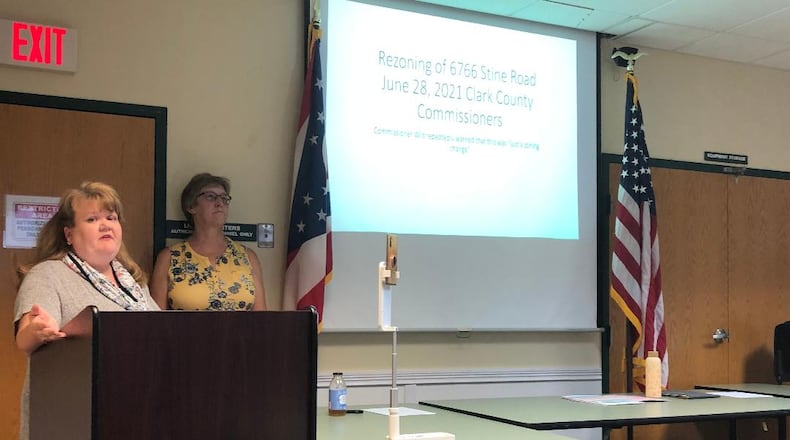A group of Mad River Twp. residents concerned about how a proposed housing subdivision could affect their community say they will pursue a referendum to try to keep the project from moving forward.
Around 60 people came to the Mad River Twp. Fire Department in Enon Wednesday to discuss steps to take in countering Hillside Creek Farms LLC’s plan to use 42 acres on the corner of Stine and Enon-Xenia Rd. for 160 new homes.
Residents Kathleen Baber, Kathy Voytko, Pam Weaver, Carol Culbertson and Kathleen Matthews came together in response to the June 28 vote by the Clark County Commissioners to rezone the 42 acres, changing the property from an agricultural district and a rural residence district to a planned district residential.
Most of the communication about the concerns was shared on social media. The number of people who showed up Wednesday surprised Baber, who shared her vision for how to address concerns about the project.
“We’re here to make a plan on how we choose to respond to the rezoning,” she said. “We’ve come in with a lot of preconceived notions and emotion. We ask you to take in all the information as a concerned community and keep an open mind. There is no perfect answer on this.”
It was also made clear the meeting wasn’t for anyone who is just opposed development in the area.
Following the commission meeting, Voytko said she did further research and presented a list of concerns the development may bring including storm water remediation, a historic cemetery’s fate, a traffic study and density. She said she spoke with Michael Baer, a Hillside Creek Farms development partner. She said he was receptive to discussing their concerns.
Drainage issues in particular created from previous developments have been ongoing for years.
Baer said last week when the rezoning was approved that new development in the area would help alleviate an existing drainage problem that was created over 50 years ago.
He said that a drainage issue was created when a housing development in the area was built there decades ago and infrastructure was not created to address that issue. He said by developing the more than 40 acres nearby, that issue would be addressed as the proper infrastructure would be built.
The project, which Baer said will take about three years to complete, must still go through the engineering process before future plans can be approved by the commissioners.
While Wednesday night’s presentation focused mainly on concerns, it also presented ways the proposed project could benefit the community.
Weaver laid out what doing a referendum entails, including the minimum number of signatures needed, steps required to get those and what could result. Following a question-and-answer session, attendees overwhelmingly voted to put forth a referendum with no opposition.
The move requires several volunteers to canvas various Mad River Twp. neighborhoods to gain the minimum 308 signatures needed to put the issue to a vote on the November ballot. Baber said she is aiming for at least 500 signatures on the petition.
The group will try to have its volunteers out seeking petition signatures within the week to meet a deadline near the end of July.
“We knew as five people we had mixed opinions but this was about getting our community together to decide,” Baber said.
By the numbers
160: Number of homes in proposed Mad River Twp. subdivision
42: Size in acreage of the proposed development
3: Number of years it will take to complete the project
About the Author
